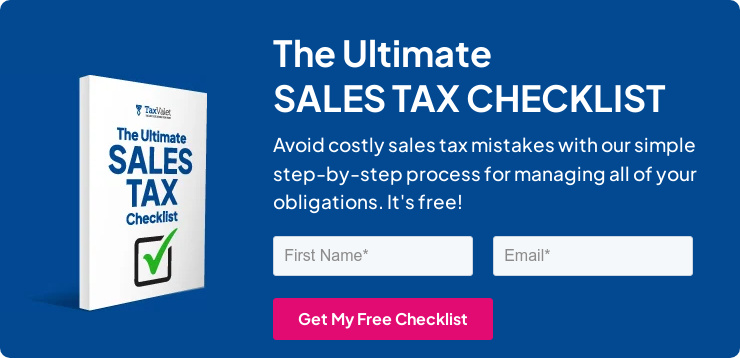Summary: This blog post explains the differences between sales tax and use tax, the importance of understanding use tax, and provides examples of how businesses may be subject to use tax.
If you’re a business based within the United States, you may be required to collect sales tax and use tax. However, many businesses don’t understand the differences between these two types of taxes. In this guide, we’ll explain what sales tax and use tax are, how they differ, and why it’s important for your business to understand them.
What is Sales Tax?
Sales tax is a tax that is collected by businesses on the sale of certain goods and services. It is a percentage of the sale price and is paid by the purchaser. The rate of sales tax varies by state and even by locality. In some states, there is no sales tax at all.
For example, if you sell a physical product on your e-commerce website for $100 and the sales tax rate in your state is 5%, the purchaser would pay $105 ($100 + $5 in sales tax). As the seller, you would be required to remit the sales tax to the state.
What is Use Tax?
Use tax is a tax that is paid on items that were purchased without paying sales tax but are used within the business. It is similar to sales tax, but the responsibility for paying it falls on the purchaser rather than the seller. Use tax is typically assessed at the same rate as sales tax.
For example, if you purchase a piece of software for your business from a vendor that is not required to collect sales tax in your state, you would be required to remit the use tax to the state. The use tax rate would be the same as the sales tax rate in your state.
The Differences Between Sales Tax and Use Tax
The main difference between sales tax and use tax is who is responsible for paying the tax. With sales tax, the seller is responsible for collecting and remitting the tax. With use tax, the purchaser is responsible for paying the tax.
Another difference is when the tax is paid. Sales tax is paid at the time of the sale, while use tax is paid after the fact.
It’s important to note that while sales tax and use tax are different, they are often used interchangeably. This can lead to confusion for businesses that are required to collect or remit these taxes.
Why Understanding Use Tax is Important
Many e-commerce businesses are not aware of their use tax obligations, which can lead to issues during a sales tax audit. If an e-commerce business is found to have underpaid use tax, they may be subject to penalties and interest.
For example, let’s say your e-commerce business sells software and you purchase $10,000 worth of software over the course of a year from vendors that were not required to collect sales tax in your state. If the use tax rate in your state is 5%, your business would owe $500 in use tax. If you didn’t remit this use tax and were audited by the state, you could be subject to penalties and interest on the $500 owed. This is why it’s crucial for e-commerce businesses to accurately calculate and remit use tax to avoid costly penalties and interest.

Examples of Use Tax for Small Businesses
E-commerce businesses often have to deal with use tax when they purchase items that they will use in their business but didn’t pay sales tax on. Here are some common scenarios where use tax may apply:
- Software and digital goods: E-commerce businesses that sell software and digital goods often purchase these items for their own use. If the vendor is not required to collect sales tax, the e-commerce business is responsible for remitting use tax.
- Equipment and supplies: E-commerce businesses may purchase equipment and supplies for their business, such as computers, office furniture, or packaging materials, from out-of-state vendors that don’t collect sales tax. In these cases, the e-commerce business is responsible for remitting use tax.
- Inventory: E-commerce businesses that purchase inventory for resale may also use some of that inventory for their own business. For example, if an e-commerce business purchases 100 t-shirts to sell on their website but uses 10 of those t-shirts as uniforms for their employees, they are required to remit use tax on the value of those 10 t-shirts.
It’s important for e-commerce businesses to keep accurate records of these purchases and to remit use tax on a timely basis.
How TaxValet Can Help
At TaxValet, we understand the nuances and complexities of sales tax and use tax. We can help your e-commerce business accurately calculate and remit sales tax and use tax, saving you time and money.
Our team of experts can assist you with everything from determining which states you have a sales tax obligation into handling your sales tax and use tax filings and payments. We can also help you stay up-to-date with changing sales tax and use tax laws and regulations.
If you’re interested in learning more about how TaxValet can help your e-commerce business with sales tax and use tax compliance, schedule a free initial consultation with us today.
Conclusion
Understanding sales tax and use tax is important for any e-commerce business that sells goods or services. By knowing the differences between these two types of taxes and accurately calculating and remitting them, you can avoid costly penalties and interest. If you need assistance with sales tax and use tax compliance, TaxValet is here to help. Contact us today to schedule your free initial consultation.
Receive Important Sales Tax Updates to Your Inbox!
Join our mailing list to receive free updates that could help protect your business from audit.
Get in Touch
Company
Disclaimer: Nothing on this page should be considered tax or legal advice. Information provided on this page is general in nature and is provided without warranty.
Copyright TaxValet 2023 | Privacy Policy | Site Map

Disclaimer: Our attorney wanted you to know that no financial, tax, legal advice or opinion is given through this post. All information provided is general in nature and may not apply to your specific situation and is intended for informational and educational purposes only. Information is provided “as is” and without warranty.
What you should do now
- Get a Free Sales Tax Plan and see how Tax Valet can help solve your sales tax challenges.
- Read more articles in our blog.
- If you know someone who’d enjoy this article, share it with them via Facebook, Twitter, LinkedIn, or email.



